In a world of constant change, organizational change management has become an important component of every business plan and strategy.
Today’s business environment requires companies to constantly undergo changes if they want to remain competitive. Factors such as globalization of markets and rapidly evolving technology force businesses to respond in order to survive.
📚Check out our article on Why Employee Communications are Better Internal Comms.
In order to adapt to new business trends, technologies, and processes, employers need to change their approach to implementing change within their organizations.
In this blog post, we will cover the pillars of successful organizational change management.
Make change management painless with the right IC tools
What is Organizational Change Management?
Organizational change is the process of transitioning from a company’s current state to some desired future state. Managing organizational change requires planning and implementing change in organizations in a way to minimize employee resistance and cost to the organization while simultaneously maximizing the effectiveness of the change effort.
According to research, one of the main reasons why organizational change projects fail is due to employees’ resistance to change as well as because of poor internal communication.
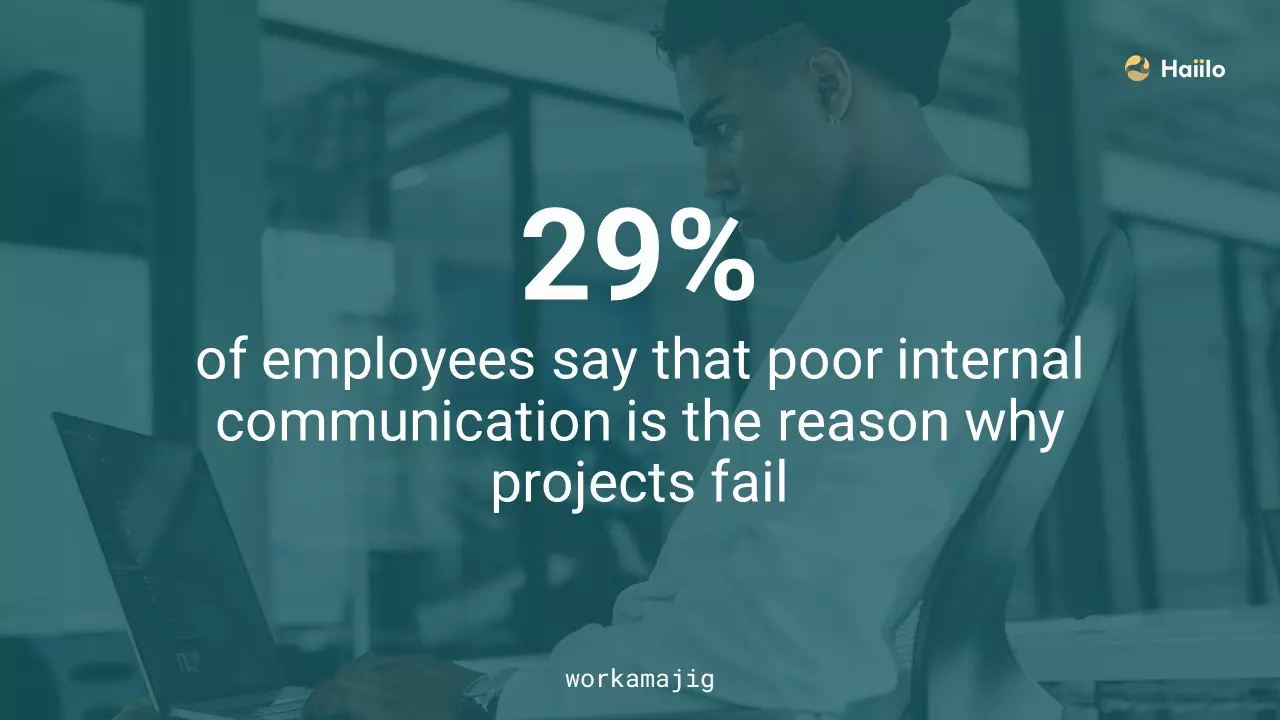
Therefore, proper employee education, as well as open and honest communication, are the key ingredients in minimizing negative employee reactions. Before the change is being implemented, employees should be informed about both the nature of the change and the logic behind it.
Some of the terms related to organizational change management include:
- Business transformation
- Change management
- Organizational transformation
- Digital transformation
- Organizational development
- Organizational innovation
- Business innovation
- Business change management
Why Should We Rethink Traditional Change Management Models?
Today, organizations need to be more agile when implementing and managing change in their organizations. Their leadership needs to be transformational, and their need to be able to inspire people and mitigate the consequences of their resistance to change.

There are two main reasons why employers need to rethink the traditional change management models:
1. Employees are the main drivers of change
In order to successfully manage organizational change, employers need to rethink traditional change management efforts and change their approach to implementing change within organizations.
When we look at the traditional models, we see that top management and leadership are the main and sole originators of change ideas. Within this approach, employees are seen as secondary implementers. When this is the case, a lot of important insights from employees about how the organization can be improved get unnoticed or neglected.
🎧 Watch our masterclass: Strategies for Driving Employee Engagement in the Workplace
Newer organizational change management models see employees as the main drivers of successful change. When employees are actively engaged in the process from the very beginning, you are much more likely to get their buy-in, eliminate resistance to change and align employees with the company’s strategic goals.
To add, organizations also need to understand their multigenerational workforce in order to adapt to their preferences, understand their fears and needs and, therefore, be more successful in organizational change initiatives.

2. Organizational change is an ongoing process
Traditionally, organizations used to think of change as projects with a starting date and an ending date. Within these projects, companies would address one or two challenges or areas for improvement such as implementing a new IT system. When the project gets completed, companies would simply go back to the old way of working until a new project comes up.
A newer approach to organizational change management says that this is an ongoing process that never ends.
As Carl Rogers put it, true change is a process, not a state of being. It has a direction, but there is no destination. Therefore, the role of organizational change managers is less to push through discrete change projects, but rather to design the organization in a way that enables continuous adaptation to an ever-evolving environment.
The Pillars of Successful Organizational Change Management
As we saw earlier, most organizational change management efforts fail. One of the main reasons why change fails is because there is a lack of alignment in the workplace. In order to make people accept new change management initiatives, employers need to be able to inspire employees and motivate them to work towards the same goals.
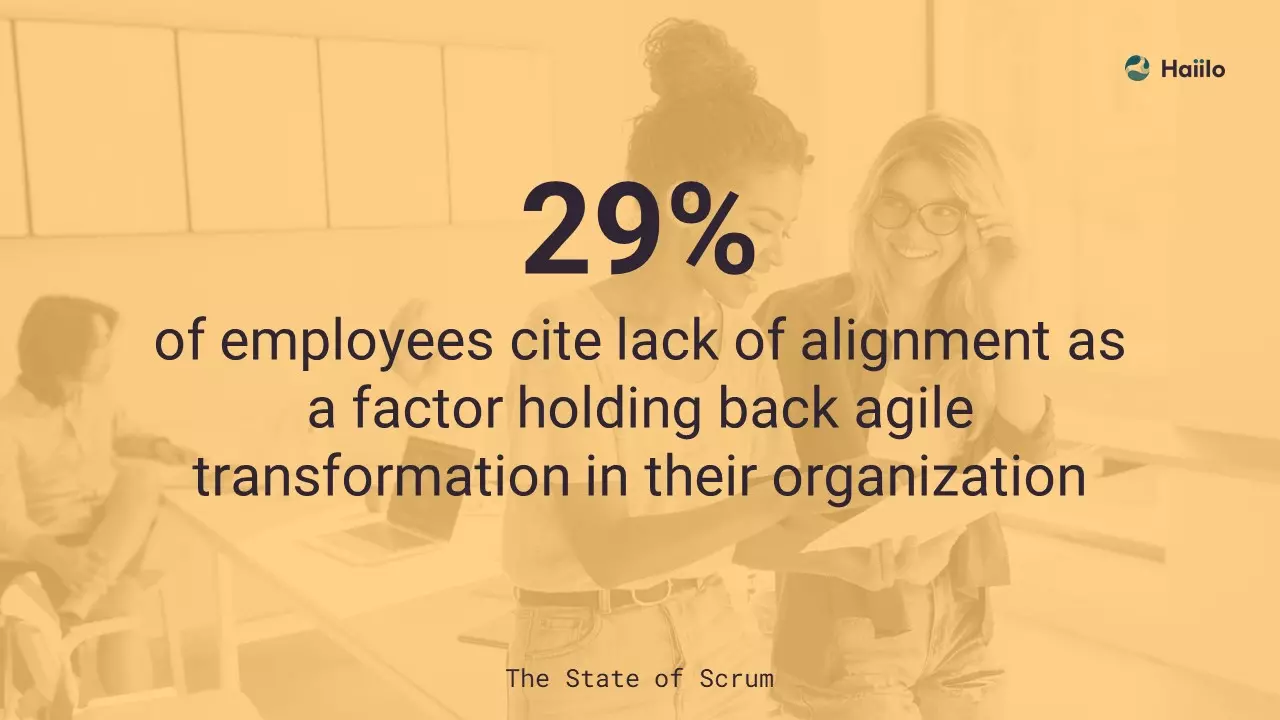
Therefore, we have put together the best practices or pillars of successful organizational change management.
1. C-Level Executives and Managers have to be on board
Even though employees should be at the heart of every change initiative, successful changes start at the top. CEOs and other C-level executives are important because their authority enables them to create a sense of urgency that is often necessary when a change is being implemented.
It is recommended for companies to set up a top-level team of experts who report to the CEO and are tasked with developing a focused vision and strategy for change. They should also be able to communicate the strategy in a way that is simple enough for all employees to understand.
However, many front-line managers still don’t have a clear understanding of why the change is happening.
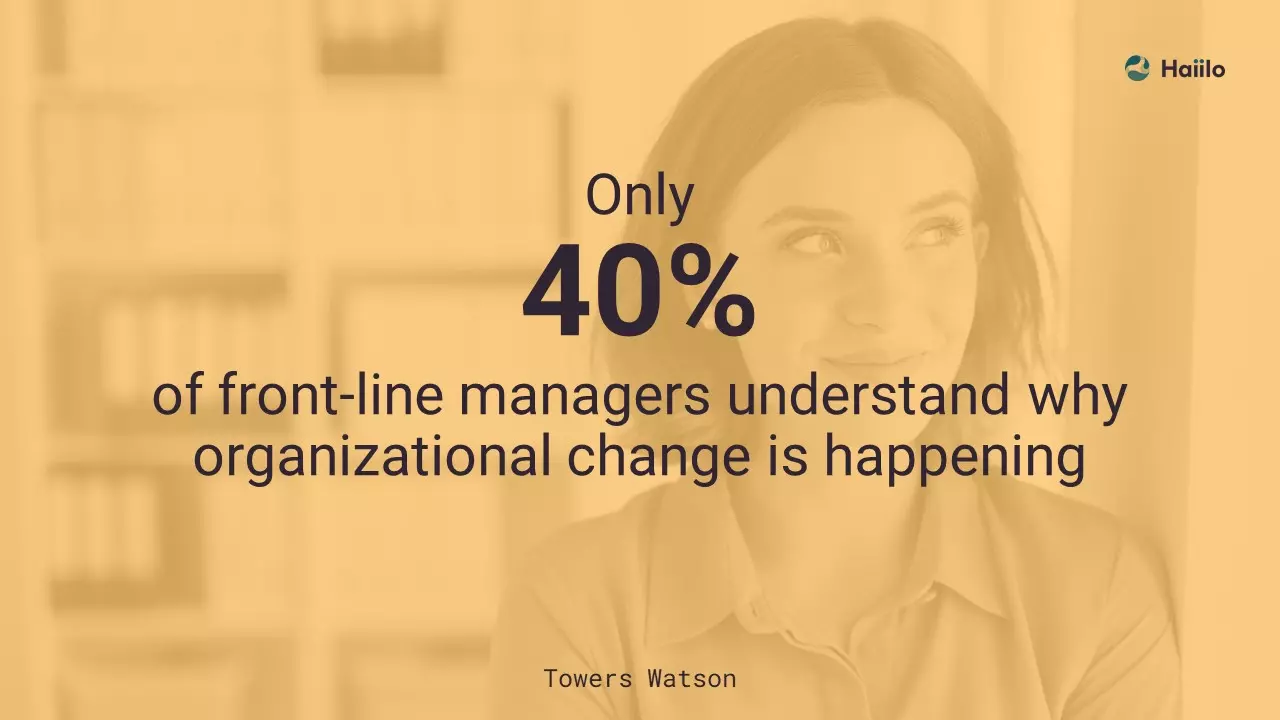
. Clear goals should be set
Starting a change without having a clear strategy and defined goals are one of the main reasons why organizational change management initiatives fail. As changes are mostly implemented to fix or improve current business situations, organizations should always identify specific outcomes expected from the change.
This is the only way employers can drive organizational alignment among all employees and make them work towards the same goals.
3. Understanding the impact of the change
Once the clear goals and objectives are set, the next step is to determine the impacts change will have on various organizational levels and even individuals.
Companies need to review the effect on each business unit. This type of information and insights helps companies determine where training and support is needed the most to mitigate the impacts.
Ask yourself these 3 questions:
- What are the impacts of change?
- Who will be affected the most?
- How will it be received?
4. Employees need to embed a change-centric mindset
As said before, without employees’ alignment, it is extremely hard to successfully implement change within organizations. However, it is employers’ duty to help employees align and develop a new, change-centric mindset.
Here, it is important to mobilize middle management to drive change in the organization. Managers need to make sure that employees grasp their role in implementing the vision and are fully on board.
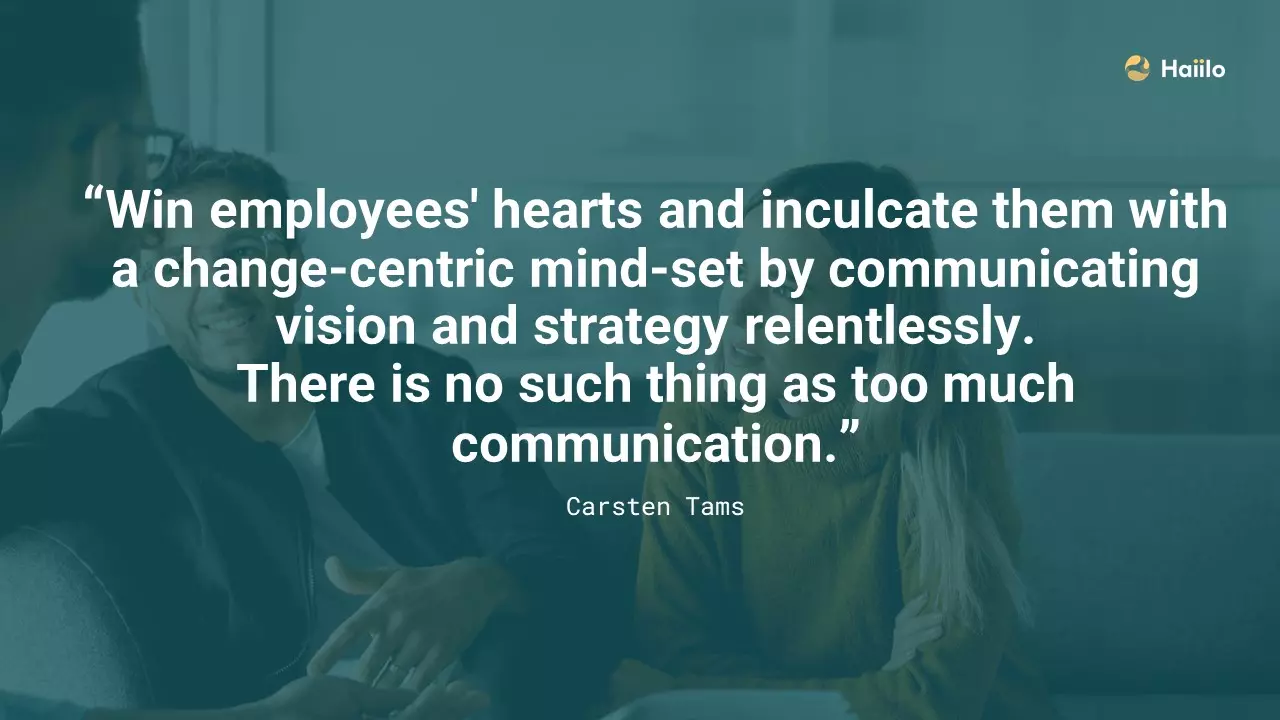
5. Employees’ psychological needs are important to understand
Self-determination is one of the basic people needs we need to better understand in order to successfully drive change within organizations and among employees. Recognizing these needs as well as the needs to be involved, heard, and empowered is important.
As Carsten Tams wrote for Forbes:
“Employees’ need for competence is undermined when their insights are disregarded. When they fear that the change process puts their employment at risk, employees’ need for relatedness is threatened.
Self-determination theory helps us understand how standard change management theory thwarts basic psychological needs, thereby undermining intrinsic motivation to support change.
…conventional change management approach alienates an organization’s most enterprising change agents.”
So what organizations can do to create change management processes that take into consideration basic human needs of autonomy and competence?
- We can satisfy employees’ needs for autonomy by inviting them
to apply their ideas to change projects. - We can empower employees to self-initiate change projects.
- By empowering employees to be originators of change ideas, we also validate employees’ competence.
- We provide employees with easy access to the skills and tools needed to master the challenges that the change process entails.
- We can cultivate a work environment in which people feel a sense of belonging, care for each other and perceive their relationship with the organization as reasonably stable.
Here is another great quote from Carsten Tams:
“The types of behaviors needed to support change processes – taking risks, assuming new responsibilities, letting go of old ones, seeking feedback, asking for help, helping others, sharing information, suggesting improvements, experimenting, talking about errors and failure – will be in greater supply in a climate marked by mutual respect, trust and psychological safety.”
6. Desired employee behaviors should be reinforced using recognition
When we talk about employee recognition, we mostly think of it as a tool to improve and drive employee motivation, engagement and performance. However, employee recognition is the best way to embed new employee behaviors that can transform any organizational culture.
Therefore, the best way to reinforce change within organizations is to reward desired employee behaviors. To do this successfully, it is important to anticipate and address resistance to change from the very start.
As most employees love to stay in their comfort zone, employers should know how to help them get out and embrace new ways of doing things.
7. Transparent, frequent and honest communications are a must-have
Most employees say that their employer is not always truthful. This lack of trust can be deadly when it comes to organizational change management initiatives. Not only that employees need to be well-informed during the whole change process, but this communication needs to be honest, transparent and it needs to go two-way. This means that sending out a newsletter to the whole organization is simply not enough.
As most employees don’t feel comfortable with change, being transparent at every step of the change management process helps to build trust and a connection with employees. Also, employers need to have a strategy on how to prevent miscommunication in the workplace.

Therefore, employers now need to turn to newer employee communication solutions that enable employees to have the main source of communications, documentation, and conversations in one central place.
8. Organizational change management requires collaboration and co-creation
Earlier in this blog, we talked about the importance of involving and empowering employees in the whole change process. Encouraging employees to share their thoughts and participate in the project make the whole process much more successful.
But to do so, employees need to have a way to collaborate and communicate easily. Here, the choice of internal communication channels is crucial.
For example, having email as the primary communication channel is not recommended. As many employees suffer from information overload because of which they often ignore their emails, choosing a more efficient communication channel is a must!

9. Change efforts should be measured
Throughout the organizational change management process, the outcomes and the impact of the initiatives should be measured. This doesn’t mean only measuring the impact of change on business profitability.
Instead, internal communicators, as well as managers, should track and measure employee engagement created with the new processes. Effective manager communication is extremely important here.
Understanding how engaged employees are with the messages shared internally can help employers evaluate their change management plan to determine its effectiveness and document any lessons learned.
Top 3 Organizational Change Management Models
In order to implement organizational change such as digital transformation, it is important to effectively plan ahead and structure the whole project.
Many organizations follow existing change management models to drive successful change in their organizations. Below, we will present the top 3 most accepted change management models. But also check out our blog with the top 5 change management models.
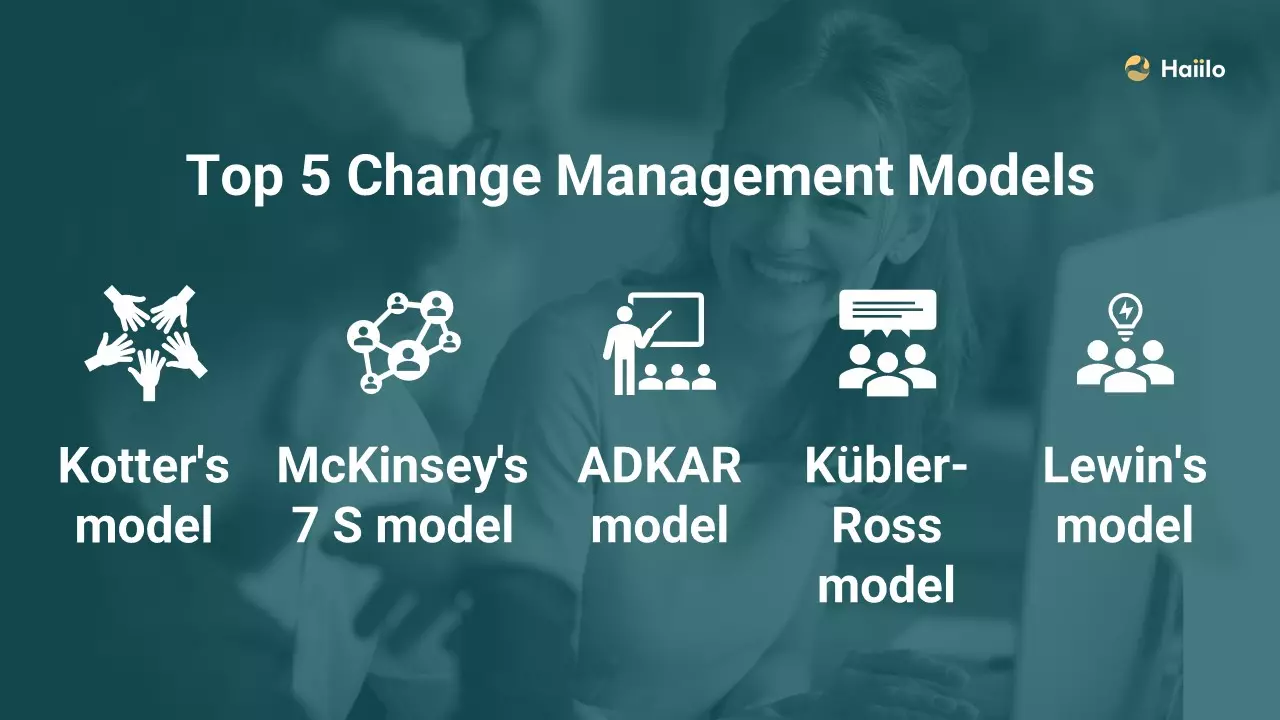
1. Kotter’s Organizational Change Management Model
Kotter’s change management theory is one of the most popular and adopted organizational change management models in the world.
This model has eight stages and each of them focuses on employees’ response to change.
- Increase urgency – When implementing change in the organization, it is important to create a sense of urgency among employees.
- Build the team – Determine the right set of skills and personalities to build a team that will successfully lead and manage the change.
- Get the vision correct – Take into account not just the strategy, but also employees’ creativity, emotions, and project’s objectives.
- Communicate – Frequently and clearly communicate with people about the changes being implemented and about the importance of these changes.
- Get things moving – Get support, remove the roadblocks and collect feedback in a constructive way.
- Focus on short-term goals – Set small goals and recognize small achievements during the process to embed new employee behaviors and drive desirable actions.
- Incorporate change – Reinforce good behaviors and make change a part of the workplace culture.
- Don’t give up – Be persistent while the process of change management is going on, no matter how tough things may seem.
2. McKinsey 7-S Organizational Change Management Model
McKinsey 7-S framework or model is one of the longest-lasting change management models out there. This model has been adopted by some of the leading organizations across the world.
This model consists of 7 crucial categories that companies should be aware of when implementing change:
- Strategy – Strategy is the long-term change management plan.
- Structure – This factor focuses on the structure in which the organization is divided.
- Systems – This stage focuses on the systems that will be used to complete day-to-day tasks and activities needed for successful change.
- Shared values – Shared values refer to the core company values or main values of an organization according to which it runs or works.
- Style – Style refers to the manner in which change is adopted or implemented.
- Staff – The staff refers to the workforce or employees and their working capabilities needed for the change to be successful.
- Skills – The competencies as well as other skills possessed by the employees working in the organization.
3. ADKAR Organizational Change Management Model
ADKAR model can be used by Change Managers to discover various gaps in the process so that effective training is provided to the employees responsible for implementing change.
ADKAR Model stands for:
- Awareness – of the need and requirement for change
- Desire – to bring and be part of the change
- Knowledge – of how to drive change
- Ability – to incorporate the change on a regular basis
- Reinforcement – to keep it implemented and reinforced later on as well.
Why Do Companies Need to Embrace Organizational Change Management?
Organizational change management should be a structured process in which companies manage and lead people through change. It is necessary that organizations have clearly defined change processes in order to successfully drive change.
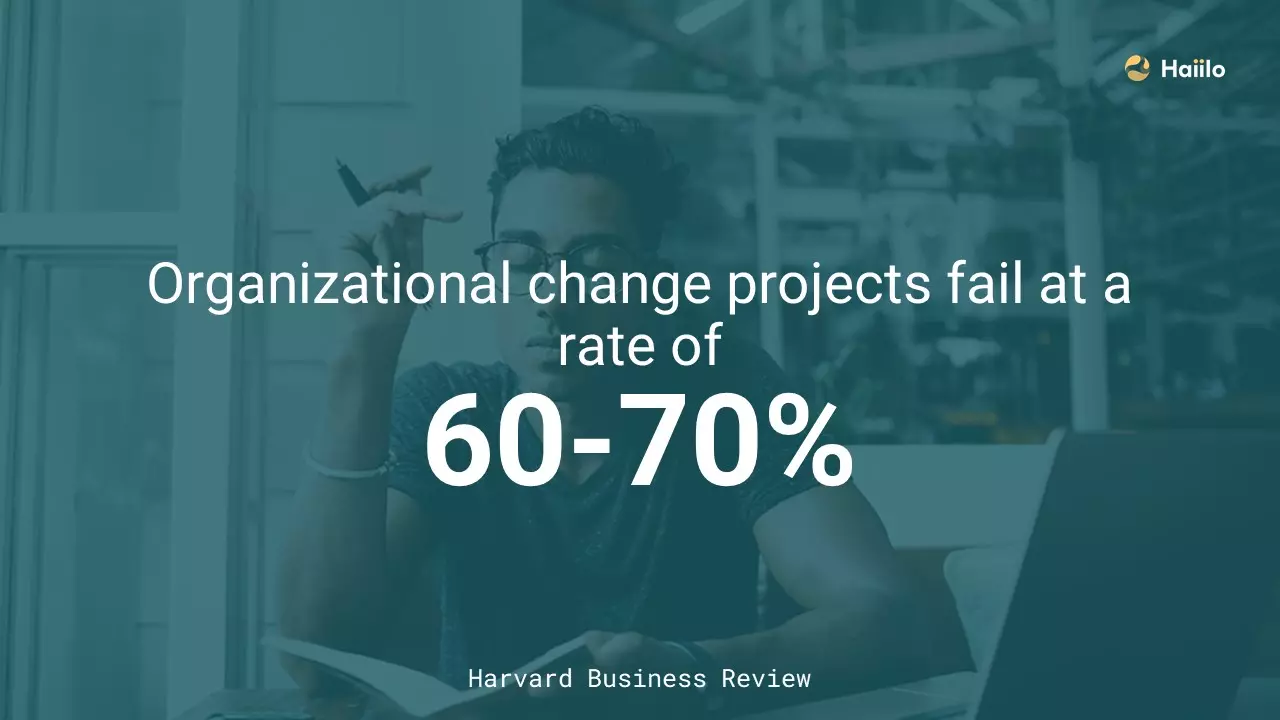
Indeed, change management reduces the risk that a new system, technology, new internal processes, or other change will be rejected by employees. The ones that don’t have structured processes are much less likely to implement change that will drive better business results.
Related: 5 Change Management Models to Take a Look At
9 Interesting Facts About Organizational Change Management
As constant organizational change has become the new normal, it is not surprising that there is an abundance of research done on change management.
We have pulled out some of the most interesting change management statistics that should never be ignored:
- 96% of organizations are in some phase of transformation, and nearly half have completed at least one transformation initiative in the past 24 months. (KPMG)
- 31% of executives admit that their organization is incapable of implementing formal innovation processes, management, and budgets. (KPMG)
- 70% of change programs fail to achieve their goals, in large part due to employee resistance. (McKinsey)
- When people are truly invested in change it is 30% more likely to stick. (McKinsey)
- 69% of the most effective change programs offered training before and after go-live. (Change)
- Nearly 75% expect to multiply the types of major change initiatives they will undertake in the next three years. (Gartner)
- Organizations with flatter organizational structures and an open-source change management strategy increase the probability of change success by up to 22%, cut implementation time by up to one-third, and reduce time spent on change by up to 12 hours per week per employee. (Gartner)
- Only 39% of employees say their organizations were effective at inspiring employees in this era of ongoing transformation. (Institute of Public Relations)
- Change management executives listed “people factors” as the biggest barriers to success. Top of their list was changing mindsets and attitudes – 58%, followed by Corporate Culture – 49%. (IBM)
Using Technology to Implement and Manage Change Successfully
Lack of or ineffective communication in the workplace influences the change management success rate. In other words, organizations that make communication a part of the process are more likely to implement change successfully.
Below are a few stats on the reasons why organizational change management efforts fail:

Haiilo, our employee communications platform is designed to help organizations be more effective in organizational change management by improving communication in the workplace.
In addition, our mobile-first mindset led us to develop a solution that is similar to platforms our employees use on a daily basis, therefore increasing employee adoption and engagement.
- Understand their internal audiences
- Easily segment audiences by location, department, job role, and many more
- Personalize communication experience in the workplace
- Spot and reward internal change ambassadors
- Keep all important updates and documents in one place
- Reach every employee at the right time with the right message
- Measure the impact of communication on specific organizational change management objectives










